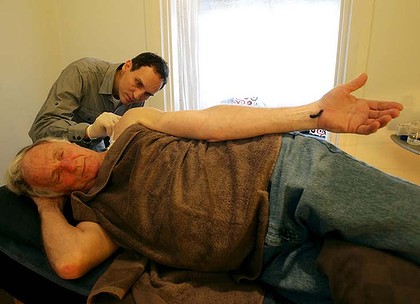Rob Brander knows what it feels like to be caught in a rip current that quickly takes you hundreds of metres from the shore. As he was being swept out to sea, some of the common advice about what to do popped into his mind, such as ”swim to the side” of the rip, he recalls. But, ”the rip was so wide I couldn’t actually see either side”.
Another favourite phrase, ”don’t worry” because the rip will bring you back to the beach, entered his head. But on this occasion he could not see the beach, just big walls of water.
”Finally, I reminded myself that I should ‘relax and don’t panic’ and was amazed that this provided me with absolutely no comfort at all,” he relates in his book, Dr Rip’s Essential Beach Book: Everything you need to know about Surf, Sand and Rips.
Dr Brander, a coastal geomorphologist at the University of NSW, threw himself into the rip in the name of science, as part of an experiment to try and understand these often deadly ”rivers of the sea”.
Now, he wants other people to do the same.
Starting in December at Shelly Beach on the central coast, his team will begin a three-year project in which four swimmers at a time will test out different strategies in a rip.
Other physical aspects of the project will be the use of new GPS-based technology to map out the paths that rips follow.
For the social science part of the project, he also wants to hear from people who have experienced being caught in a rip anywhere in the world. They can fill in an online survey at sls.com.au.
”I’ve been studying and measuring rips for years but it occurred to me that no one has really thought to talk to people who’ve been caught in rips to understand their experience and response.” This is the best way to find out what sort of educational message would be most effective in future, he says.
”We want to find out how often they go to the beach. Why did they swim where they did? Do they remember how they got caught in the rip? What did it feel like? Did any safety messages come into their head and what did they do? Did they swim out or suddenly stand up? Or were they rescued? ”
Rips are the main cause of nearly 100 drownings and more than 25,000 surf rescues in Australia each year.
”In particularly bad summers, someone will drown in a rip approximately every three days,” Brander says. Yet, rips get nowhere near the publicity that rare shark attacks do.
No one has really thought to talk to people who’ve been caught in rips to understand their experience and response.
To remind people about this hazard, Surf Life Saving Australia, which is the industry partner in the Australian Research Council Linkage Grant project, will carry out an eye-catching demonstration this Saturday.
A harmless purple dye will be released into a rip at every beach in Sydney and at other locations around Australia.
Brander has used this technique many times to track the movement of rips. His students have also watched how oranges travel in the surf.
Often the oranges flow in a large circle and come back to the beach within five to ten minutes, he says. Sometimes they head offshore, never to be seen again.
At other times, they disappear. ”But when we come back an hour later, the beach is covered in oranges.”
The new technology the team will use are drifters – devices that look like mini rockets and float through the surf like a swimmer would. They have GPS units attached to indicate speed, distance travelled, and eventual position.
Brander says the accepted wisdom has long been that rips flow out to sea. But recent studies with drifters in the US, UK and France suggest rips flow in circles, without going beyond the breaking waves, about 80 per cent of the time.
Only about 20 per cent would ”squirt” people out the back.
This confirms what he has observed using dyes and oranges, and could have significant implications for safety messages.
”If most of them recirculate, maybe they’re not as scary as you think.”
Two years ago, Surf Life Saving Australia launched a national rip education campaign that caused heated debate. It was based on the message, ”to escape a rip, swim parallel to the beach”.
Critics, including professional lifeguards and surf safety educators such as the former ironman champion, Craig Riddington, claimed it was a potentially dangerous message because many people who get caught in rips are poor swimmers and would waste energy trying to swim parallel to the beach. Staying calm and afloat, conserving energy and signalling for help was a safer approach, they argued.
The new project, which will initially involve lifesavers who are strong swimmers wearing GPS units, will examine this question.
Four will go into a rip at a time, two of whom will swim across the rip and two who will simply see where it takes them, while other lifesavers watch on, ready to assist.
Apart from at Shelly Beach, tests will be carried out Gunnamatta Bay in Victoria, a notorious beach for rips, and at a beach along the Surfers Paradise strip.
Brander says the good thing that came out of the furore about the swim parallel campaign was that it drew people’s attention to rips.
It was an unwinnable debate, he says. Swimming parallel will work for some swimmers, while staying afloat will work for others. And he suspects that most average swimmers who get caught in a rip panic and tend to forget any advice anyway.
It is much better to not get caught in a rip in the first place. ”The important thing is we’ve got to start educating people how to spot rips,” Brander, who had made popular youtube videos on rip spotting, which are also available on his science of the surf website, says.
Just as with looking both ways before crossing the road, it should become second nature to spend five to 10 minutes looking for rips on arrival at the beach. Yet, research has shown that 60 per cent of holidaymakers on popular NSW beaches could not spot a rip when shown a picture of one, and international tourists from countries without beach culture are likely to be even less knowledgeable.
Bondi – how a valley turned into a beach
About 300 million years ago Australia was part of a supercontinent known as Gondwanaland, which also consisted of South America, Africa, India, New Zealand and Antarctica.
The Australian landscape was already being shaped at this time with mountains to the north, south and west of present-day Sydney leaving a bowl-shaped basin in the middle.
About 230 million years ago, while dinosaurs ran amok, this basin started to fill up with layers of sediments carried by massive river systems. Some of the sand layers turned into sandstone rock, most notably a 300-metre-thick layer that people walk along today called the Hawkesbury sandstone.
As the supercontinent slowly started to break up, Australia gradually moved northwards, with New Zealand breaking away about 120 million years ago.
The divorce was slow, taking about 40 million years as the Tasman Sea opened up to the north like a zipper between the two land masses. This left the brand new east coast of Australia with a steep and narrow continental shelf exposed to large waves that started to slowly erode the Hawkesbury sandstone cliffs, leaving behind a rock platform and a very indented coastline.
The opening of the Tasman also triggered more river erosion on the Australian continent resulting in huge amounts of sand being dumped on the continental shelf.
During the past 2 million years, the sea level has been going up and down like a yo-yo.
The last ice age was 18,000 years ago and the sea level was 120 metres lower than it is today.
Present-day Bondi wasn’t even a beach, but a small valley covered in native vegetation, because the beaches were about 25 kilometres to the east.
As the earth warmed up, the ice melted and the sea level rose rapidly about 6500 years ago to the level it is today.
As it rose, the sand lying on the continental shelf was bulldozed landward, ultimately filling up the coastal indentations when it stopped.
And that is how Bondi formed.
The sand you see today is pretty much the same sand that’s been sitting there for about 6500 years, but the sand grains themselves are millions of years old and probably came from inland Australia.

 IF YOU think your job sucks spare a thought for the Richardsonianus australis, a species of leech increasingly being used for medicinal purposes.
IF YOU think your job sucks spare a thought for the Richardsonianus australis, a species of leech increasingly being used for medicinal purposes. The youth population is continuously increasing, and is estimated to reach 1.8 billion this year. Obviously, it is a large population of mass power. Yet, as we say goodbye to another year’s International Youth Day, as the new Youth Advisor for the Global Education Monitoring (GEM) Report, I think it crucial to point out that a vast portion of youth energy remains confined by physical and mental chains in countries affected by war and conflict. This must be addressed.
The youth population is continuously increasing, and is estimated to reach 1.8 billion this year. Obviously, it is a large population of mass power. Yet, as we say goodbye to another year’s International Youth Day, as the new Youth Advisor for the Global Education Monitoring (GEM) Report, I think it crucial to point out that a vast portion of youth energy remains confined by physical and mental chains in countries affected by war and conflict. This must be addressed. Last week marked International Youth Day, with the theme of poverty and hunger matters. This theme did not go far enough. It should have been expanded to include the very important, tight and vital link between global goals 1, 2 and 4: Poverty, Hunger and Quality Education.
Last week marked International Youth Day, with the theme of poverty and hunger matters. This theme did not go far enough. It should have been expanded to include the very important, tight and vital link between global goals 1, 2 and 4: Poverty, Hunger and Quality Education. One can’t deny the massive challenges that Syria faces in providing a good quality education. Yet I have seen progress in this matter being made with new initiatives to teach out-of-school children and young people. There are now scholarships awarded to highly ambitious Syrian students in addition to many new online learning platforms, allowing them to learn from home, rather than venture outside.
One can’t deny the massive challenges that Syria faces in providing a good quality education. Yet I have seen progress in this matter being made with new initiatives to teach out-of-school children and young people. There are now scholarships awarded to highly ambitious Syrian students in addition to many new online learning platforms, allowing them to learn from home, rather than venture outside. LOCAL councils are raking in more than $100 million a year in parking fees and fines as metropolitan roads become more congested.
LOCAL councils are raking in more than $100 million a year in parking fees and fines as metropolitan roads become more congested. I’ve always been of the opinion that if Carrie Bradshaw had popped onto our television screens in 2010 instead of 1998, she would have been a blogger. But alas, she didn’t, so she wrote a (gasp!) print column for the fictional New York Star newspaper.
I’ve always been of the opinion that if Carrie Bradshaw had popped onto our television screens in 2010 instead of 1998, she would have been a blogger. But alas, she didn’t, so she wrote a (gasp!) print column for the fictional New York Star newspaper.
